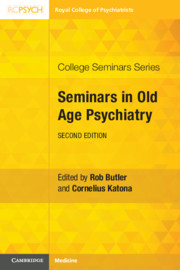Book contents
- Seminars in Old Age Psychiatry
- College Seminars Series
- Seminars in Old Age Psychiatry
- Copyright page
- Contents
- Contributors
- Preface
- Note
- Chapter 1 Healthy Ageing
- Chapter 2 Clinical Assessment
- Chapter 3 Cognitive Assessment
- Chapter 4 Imaging
- Chapter 5 Delirium
- Chapter 6 Alzheimer’s Disease
- Chapter 7 Vascular Dementia
- Chapter 8 Dementia with Lewy Bodies
- Chapter 9 Frontotemporal Dementia
- Chapter 10 Depression
- Chapter 11 Bipolar Disorder
- Chapter 12 Psychosis
- Chapter 13 Anxiety Disorders
- Chapter 14 Drug and Alcohol Misuse
- Chapter 15 Attention Deficit Hyperactivity Disorder
- Chapter 16 Medications
- Chapter 17 Electroconvulsive Therapy and Neurostimulation
- Chapter 18 Psychological Therapies
- Chapter 19 Role of an Old Age Psychiatrist
- Chapter 20 Consultation-Liaison
- Chapter 21 Palliative Care
- Chapter 22 Care Homes
- Chapter 23 Carers
- Chapter 24 Law, Capacity and Ethics
- Chapter 25 Migrants, Refugees and Asylum Seekers
- Chapter 26 Clinical Scenarios
- Index
- References
Chapter 6 - Alzheimer’s Disease
Published online by Cambridge University Press: 21 June 2019
- Seminars in Old Age Psychiatry
- College Seminars Series
- Seminars in Old Age Psychiatry
- Copyright page
- Contents
- Contributors
- Preface
- Note
- Chapter 1 Healthy Ageing
- Chapter 2 Clinical Assessment
- Chapter 3 Cognitive Assessment
- Chapter 4 Imaging
- Chapter 5 Delirium
- Chapter 6 Alzheimer’s Disease
- Chapter 7 Vascular Dementia
- Chapter 8 Dementia with Lewy Bodies
- Chapter 9 Frontotemporal Dementia
- Chapter 10 Depression
- Chapter 11 Bipolar Disorder
- Chapter 12 Psychosis
- Chapter 13 Anxiety Disorders
- Chapter 14 Drug and Alcohol Misuse
- Chapter 15 Attention Deficit Hyperactivity Disorder
- Chapter 16 Medications
- Chapter 17 Electroconvulsive Therapy and Neurostimulation
- Chapter 18 Psychological Therapies
- Chapter 19 Role of an Old Age Psychiatrist
- Chapter 20 Consultation-Liaison
- Chapter 21 Palliative Care
- Chapter 22 Care Homes
- Chapter 23 Carers
- Chapter 24 Law, Capacity and Ethics
- Chapter 25 Migrants, Refugees and Asylum Seekers
- Chapter 26 Clinical Scenarios
- Index
- References
Summary
Alzheimer’s disease (AD) is an irreversible, progressive neuro-degenerative disorder of the brain that affects various aspects of cognitive functions. It manifests as a progressive impairment of day-to-day functioning, eventually leading to a breakdown of even the simplest abilities. It is the commonest cause of dementia in the world. It is a major cause of disability, dependency and carer stress among older people. It places an immense burden on society and is one of the top 10 causes of mortality worldwide [1].
- Type
- Chapter
- Information
- Seminars in Old Age Psychiatry , pp. 67 - 78Publisher: Cambridge University PressPrint publication year: 2019

